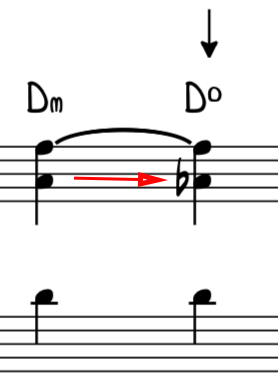6 Essential Passing Chords For Pop Piano
Learning Focus
Music Style
Free Lessons
Get free weekly lessons, practice tips, and downloadable resources to your inbox!
Good versus evil. Eventually, good wins. Boy meets girl. Eventually, they fall in love. These are the fundamental storylines of many of the stories we love. So why do we watch and read them? Because we love the journey! The twists and turns. The transitions, developments, arrival, etc. Music is much the same: most of the underlying fundamental chord progressions are very similar. It’s the journey and transitional material where the interest lies. That is where learning passing chords for pop piano comes in!
Most pop piano players in the beginning simply go from basic chord to another basic chord for the entire chord progression. This creates a very dull and plain sound that many listeners will find uninspiring (like our basic storylines, they’ve heard it many times). That’s why we need to spice things up with passing chords and reharmonizations to really make our pop chords pop, whether arranging covers for piano or in writing for our original music.
In this lesson, we are going to take a simple melody and chord progression called “Happy Days,” and add 6 types of passing chords for pop piano.
You’ll learn:
- The melody of a pop song and analysis of its basic fundamental chords
- Increasing motion and direction in-between chords using secondary dominant passing chords
- How inversions act as a glue in many ways to connect different chords
- Introducing a minor sound on certain chords to keep the flow going
- Reharmonizing dominant chords with sus chords for rich color
These are extremely valuable tools for any musical style.
Excited? Let’s dive in!
Learn The Basic Pop Melody and Chord Progression
Here are the melody and chord progression to the pop song we’ll be using in this lesson:

The first step, as with any song or chord progression, would be to learn and play it until it feels easy.
Now, before we can spice it up with passing chords and such, we want to first know and understand the fundamental chord progression so we what we’re working with. To do this, we analyze each chord with roman numerals based on the song’s key and scale. In this case, the key of C major:

These roman numerals essentially provide for us a code(instead of random chords one after another). Not only can we use this code to play the chord progression in other keys but we can gather the general “roles” of each chord in the music. Then we’ll know much better our options are for adding interesting passing chords and reharmonizations!
If you don’t know yet your diatonic chords, their roles in music, or roman numeral analysis then check out our Key of C Major course and our Beginner Piano Foundations Learning Track (Part 1, Part 2).
Passing Chord #1: Secondary Dominant Chords in Second Inversion
Don’t be afraid of that name, it’s much easier than it sounds. Check out the version of “Happy Days” with all the passing chords and reharmonizations. You’ll see circled all the instances of passing chord #1:

There are two great concepts at play here that make it a perfect passing chord. Secondary dominants and use of chord inversion. Let’s briefly discuss each. We’ll discuss the first one in this section and the second in the next.
Chord progressions are kind of like playing with magnets of varying strengths. For example, while many chords have a “pull” towards one another, the strongest magnet we know is the V7(dominant)-I chord progression. But why should this intense “pull” be limited to just the V and I of the key?
This is the concept behind secondary dominants. They are intensifiers that can create a greater pull from any chord you’re currently playing and any following chord. This is done by using inserting the dominant of the destination chord in between a chord you’re on and the next chord you’re heading to. Check out the difference in”pulling” power or intensity of the two chords, with and without a secondary dominant:

As you can see we had a C major to A minor, which sounds nice already. But then we threw in the dominant of A minor (E7) in between C and A minor (the secondary dominant). Quite a difference in the intensity, right? Adding secondary dominants is like adding a much more intense magnet that pulls you to the next chord!
As you can see, to do this well you would need to know all your dominant 7th chords and the V of each of key/chord. You can learn this in our Dominant 7th Chord Theory and Application in the Intermediate Piano Foundations Learning Track.
Passing Chord #2: Secondary Dominant Chords in First Inversion

This passing chord is also a secondary dominant, but it uses a different inversion than the first. If you haven’t learned all your inversions check out major and minor chord inversions and the dominant 7th chord exercises.
So why are we using inversions instead of just root position chords here? There are 2 primary reasons:
The first being that root position chords in general sound very strong and emphasized. Playing all root position chords is like having every scene in a movie be as equally as dramatic as the last. This might work in certain contexts, but when used too much it actually decreases the dramatic effect the root position chords create.
Especially in the context of passing chords when we want the destination chord to stand out more than the passing chord, we use an inverted passing chord instead of a root position one. This softens the intensity of the passing chords while still having some of that increased “pull” to the destination chord from the secondary dominant. Check out the difference below between root position and inverted secondary dominant chords:

Second, notice the bassline that we create with the inversions below (notated with slash chords above the staff):

These types of inversions for the passing chords are selected because of the nice connected melody the bass plays down below. This connects the ideas much more than a bassline that jumps around everywhere.
For these two reasons, inversions act more like a “glue” between chords rather than calling attention to themselves!
Passing Chord #3: Inverted Diatonic Chords
There is one example of this in our song here:

This is generally the simplest type of passing chord for pop piano. You simply make a melodic bassline and harmonize it with a diatonic chord that sounds nice.
This is a similar concept to the last one but it’s simply more of a “glue.” It doesn’t intensify the pull as does a secondary dominant passing chord.
Passing Chord #4: Borrowing From Minor
Check out this passage here:

That D diminished following the D minor is actually borrowed from C minor. We generally can interchange chords from major and minor versions of the scale. Remember though, it can be quite a sudden shift in sound to the listener if not done carefully.
Take a look below at the middle line this passing chord creates:

This chromatic line smoothly connects our D minor to our D diminished and then later follows to the G chord. Following the same principle as inversions, this melodic line also acts as a “glue” that connects the two chords!
Passing Chord #5: Inverting the Original Chords
These last two can be considered either passing tones or reharmonizations of the chord progression.
Check out the subtle difference in the character of the last two bars of the original chords versus our more advanced version with passing chords:


As you can see we inverted the D7 chord. As discussed earlier, this decreases some of the strength of the chord but allows for a nice stepwise melody in the bass. The 3rd of the D7 resolves nicely into the root of the G7 chord.
Just simply playing with inversions of the original chords can really make for nice sounding chords and passing chords for pop piano.
This is also a great technique for pop piano accompaniment. If you want a deeper dive into that then check out Pop & Contemporary Accompaniment Patterns (Beginner/Intermediate, Intermediate/ Advanced).
Passing Chord #6: Sus Chords

If we raise our third of a dominant 7th chord up a half step, we get a dominant 7th sus chord. This creates a beautiful floaty sound that generally wants to pull that 3rd down back down into its place:

Sus chords are always a nice technique to use on dominant 7th chords to keep the chord progression moving and propelling forward.
Summing It All Up
I hope you’ve enjoyed this lesson on passing chords for pop piano. Be sure to take these concepts and apply them to as many chord progressions and songs as you can.
If you want a deeper dive into the pop piano, passing chords, reharmonization, and more, check out some of the following courses:
- Passing Chords and Reharmonization (Beginner/Intermediate, Intermediate/Advanced)
- Pop and Contemporary Piano Accompaniment: Popstinatos
- Pop and Contemporary Piano Accompaniment: The One Chord Wonder
- Contemporary Progressions and Improv (Beginner/Intermediate, Intermediate/Advanced)
- Film Improvisation
Thanks for reading this Quick Tip, see you in the next one!
Blog written by Daine Jordan/Quick Tip by Jonny May
More Free Lessons
Some jazz standards like “On Green Dolphin Street” mix Latin and swing within the same song…Learn how to master these “transition tunes.”
Learn to play in the exhilarating rock and roll piano style of Little Richard and Jerry Lee Lewis—including grooves, chords, licks and riffs.
Explore the methods and mindset needed to comp on piano in the swing style with this complete guide to jazz piano comping for all levels.
Looking for downloads?
Subscribe to a membership plan for full access to this Quick Tip's sheet music and backing tracks!
Join Us
Get instant access to this Quick Tip and other member features with a PWJ membership!
Guided Learning Tracks
View guided learning tracks for all music styles and skill levels
Progress Tracking
Complete lessons and courses as you track your learning progress
Downloadable Resources
Download Sheet Music and Backing Tracks
Community Forums
Engage with other PWJ members in our member-only community forums
Become a better piano player today. Try us out completely free for 14 days!



